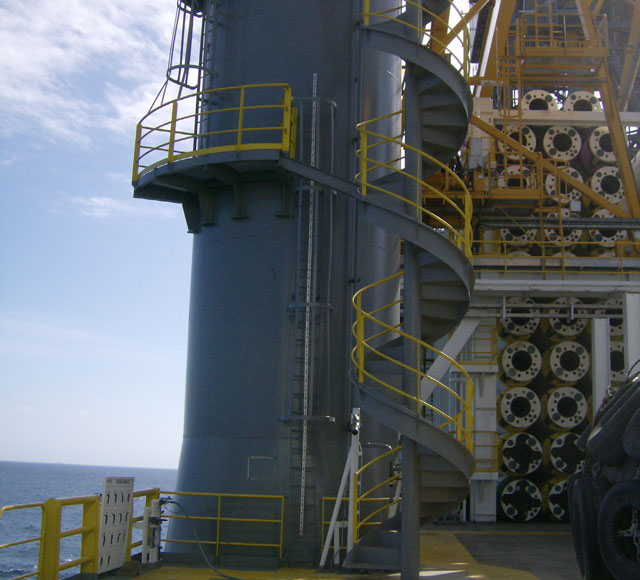Fall Protection for Oil Rigs and Drilling Platforms
Although spills and contamination are often cited as main safety concerns associated with offshore oil exploration, your platforms pose significant fall hazards. Offshore oil rig work platforms are typically 100 feet or more above the surface of the ocean, and this height, when combined with the constant motion due to the effects of currents and waves, puts employees and contractors at risk. Land based rigs lack the perpetual motion caused by ocean currents, but they also contain the ladders, derrick platforms, and riser stacks that expose workers to fall hazards.

Guardrail and Vertical Ladder systems provide a comprehensive fall protection package

Guardrail and Vertical Ladder systems provide a comprehensive fall protection package
Whether your organization focuses on offshore or onshore production, ensuring BSEE and OSHA compliance and worker safety requires a comprehensive fall prevention strategy, which includes the proper mix of fall protection equipment, a descent and rescue plan, personnel training, and partnering with a fall protection company that appreciates the unique nature of the potential fall hazards associated with offshore and onshore drilling.
We are a complete turnkey provider of engineered fall protection systems designed for the oil industry. DFP engineers and certified installers carry a number of credentials specific to the oil industry, including Basic Offshore Safety Induction and Emergency Training, ADC HSW Rig Pass / SafeGulf, and GoM License to Go Offshore.
Fall Protection Solutions
-
Guardrail
View Guardrail -
Horizontal Lifelines
View Horizontal Lifelines -
Rescue and Descent Systems
View Rescue and Descent Systems -
Vertical Lifelines and Ladder Systems
View Vertical Lifelines and Ladder Systems -
Vertical Rigid Track Systems
View Vertical Rigid Track Systems
Design Considerations
Offshore Oil Industry Fall Protection Design Considerations
The corrosive effects of salt and the perpetual motion of an offshore oil platform fall protection makes and fall arrest systems are subjected to Because petrochemical plants process corrosive and caustic materials, material selection is a key consideration in system design. Petrochemical fall protection and fall arrest systems are typically fabricated using galvanized rather than powder coated or painted materials to ensure chemical resistance. Non-sparking synthetic cable systems are often specified in petrochemical applications to minimize the risk of accidental sparking and explosions.
Prolonged exposure to materials found in petrochemical plants may pose significant health and safety risks to maintenance personnel, so ease of use is another important factor when evaluating system design. The finished fall arrest system must be easy to use, fall protection systems must not be cumbersome, and personnel must be able to complete their assigned tasks and leave the work area quickly.
Our years of experience in the petrochemical industry, installation expertise, and awareness of your unique access will help us implement a turnkey fall protection system that keeps your employees safe and your facility in compliance with all OSHA regulations.
OSHA Regulations
- HLL/VLL
- 1926.502(d)
'Personal fall arrest systems.' Personal fall arrest systems and their use shall comply with the provisions set forth below. Effective January 1, 1998, body belts are not acceptable as part of a personal fall arrest system. Note: The use of a body belt in a positioning device system is acceptable and is regulated under paragraph (e) of this section. - 1926.502(d)(8)
Horizontal lifelines shall be designed, installed, and used, under the supervision of a qualified person, as part of a complete personal fall arrest system, which maintains a safety factor of at least two. - 1926.502(d)(9)
Lanyards and vertical lifelines shall have a minimum breaking strength of 5,000 pounds (22.2 kN). - 1926.502(d)(10) 1926.502(d)(10)(i)
Except as provided in paragraph (d)(10)(ii) of this section, when vertical lifelines are used, each employee shall be attached to a separate lifeline. - 1926.502(d)(11)
Lifelines shall be protected against being cut or abraded. - 1926.502(d)(12)
Self-retracting lifelines and lanyards which automatically limit free fall distance to 2 feet (0.61 m) or less shall be capable of sustaining a minimum tensile load of 3,000 pounds (13.3 kN) applied to the device with the lifeline or lanyard in the fully extended position. - 1926.502(d)(13)
Self-retracting lifelines and lanyards which do not limit free fall distance to 2 feet (0.61 m) or less, ripstitch lanyards, and tearing and deforming lanyards shall be capable of sustaining a minimum tensile load of 5,000 pounds (22.2 kN) applied to the device with the lifeline or lanyard in the fully extended position.
- 1926.502(d)
- Ladders
- 1926.1053(a)(18)
Fixed ladders shall be provided with cages, wells, ladder safety devices, or self-retracting lifelines where the length of climb is less than 24 feet (7.3 m) but the top of the ladder is at a distance greater than 24 feet (7.3 m) above lower levels. - 1926.1053(a)(19)
Where the total length of a climb equals or exceeds 24 feet (7.3 m), fixed ladders shall be equipped with one of the following: - 1926.1053(a)(19)(i)
Ladder safety devices; or - 1926.1053(a)(19)(ii)
Self-retracting lifelines, and rest platforms at intervals not to exceed 150 feet (45.7 m); or - 1926.1053(a)(19)(iii)
A cage or well, and multiple ladder sections, each ladder section not to exceed 50 feet (15.2 m) in length. Ladder sections shall be offset from adjacent sections, and landing platforms shall be provided at maximum intervals of 50 feet (15.2 m). - 1926.1053(a)(20)
Cages for fixed ladders shall conform to all of the following:
- 1926.1053(a)(18)
Talk to a fall protection specialist
Tell us about your fall protection needs, and we’ll configure a system that rises to your challenges.

